| |
|
|
| |
|
|
| |
 |
|
| |
|
|
| |
|
|
| |
|
|
| |
|
|
| |
 |
|
| |
|
|
| |
|
|
| |
|
|
| |
16 points for Morris the Cat: 11 for the hit and five for the solo. So of course I made him (er, asked him to) write the update. Nothing fancy, I said, and he ignored me. Lovely update.
* * *
No. 21 in the program, but No. 1 in Memphis college basketball fans' hearts. That was Larry Finch.
Finch died at 60 -- an age which, as a number, would be considered a scorer's sensational night.
There was nothing sensational about the last decade of Finch's life. A massive stroke in 2002 led to a number of rehabilitation facilities and hospitalizations before the scoreboard clock finally clicked down to zero for Finch. The officials gathered by the scorer's table, looked at replays, and determined there would be no overtime in this game.
But let's forget about all the basketball cliches and remember what one hoop star meant to a western Tennessee city known more for Elvis than roundball.
Much like Elvis, since his death, people are already discussing plans to erect statues of Finch all over Memphis. He left the university as its career leading scorer, and he still ranks fourth with 1,869 points. In the 1973 NCAA tournament title game, the guard scored 29 points in a losing effort against coach John Wooden's powerful UCLA squad. (Some other player, a center named Bill Walton, scored 44 points in that game.) Finch was drafted by the Los Angeles Lakers in 1973 but signed instead with the Tams -- the Memphis Tams, of course -- of the American Basketball Association. Finch went on to be a coach -- at Memphis, of course -- and his teams won 220 games against only 130 losses from 1986 to 1997. He took the Tigers to the NCAA tournament six times, including a run to the Round of 8 in 1992.
But that's his basketball career. Why else is Larry Finch so beloved in Memphis? Because he was recruited at a time when very few black players got a chance to play big-time college basketball for a program in the racially charged state of Tennessee. But, wrote columnist Zach McMillan of The Memphis Commercial Appeal: " ... through basketball and his transparent pride in the city of Memphis, Finch helped force a transformation in thinking -- even if the actions needed to improve race relations would take more time to move forward."
McMillan went on to relate this "true story" about Finch:
On the day before Finch played his first varsity game for what was then called Memphis State, the City Council met with the legendary publisher of The New York Times, Arthur Ochs Sulzberger.
In the process of acquiring a local TV station (WREG-TV, Channel 3), Sulzberger asked the council to name the city's biggest problem. The answer: race.
"There is as much polarization at the grass-roots level as ever, maybe more," the Rev. James L. Netters was quoted as saying. "One serious event, one big event could ignite it again."
When Finch's time as a player had finished, in that loss to Bill Walton and UCLA in the first Monday night championship game, the city was still struggling with how to deal with race. And it may always.
But something had happened. The Commercial Appeal, the same newspaper that had enraged black Memphians with caricatured illustrations of black people in the '60s, ran a cartoon the day after Finch and the Tigers returned from that title-game loss to St. Louis.
It depicted two boys -- one white, one black -- sitting on a sidewalk, looking slightly dejected. Behind them a sign read: "Larry we love you!!!"
— Morris the Cat
|
|
| |
|
|
| |
 |
|
| |
|
|
| |
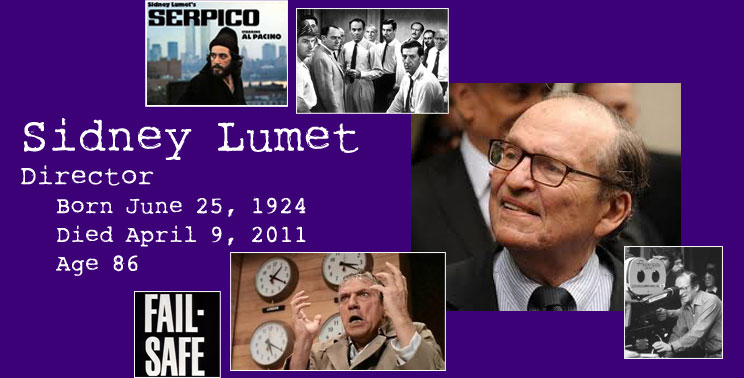 |
|
| |
|
|
| |
Written with an assist from the man who's sat next to me at a few thousand films. (Averaging twice a week for 35 years.)
* * *
Everyone has a favorite Sidney Lumet film, right? Whether it's Long Day's Journey Into Night or Dog Day Afternoon or Network, or even lesser known gems like the first (and possibly still the best) John Le Carre adaptation The Deadly Affair, or Running on Empty or that wonderful little surprise, Garbo Talks. There was a reason we looked forward to new Lumet movies, and it wasn't only for the great performances by the leading actors in films by a great actor's director. There was a sense of Old Left decency and plain old fair play, too, that Lumet films projected, from 12 Angry Men through The Verdict and Daniel. And then there was the easy way that he threw characters at the audience in bunches.
Even so, one is tempted to place Lumet into that "not quite great" category that Andrew Sarris termed the "far side of paradise." And here's why.
Having entered film from the theater and live TV drama, Lumet seemed to be Hollywood's go-to guy for adaptations of plays. But how much value did he add to those adaptations? Equus and Deathtrap are as pointless on screen as they are on stage. And whose idea was it to have Lumet work on a musical (The Wiz)? Or on the remake of Cassavetes' Gloria? And why would anyone think he'd be better at star-wrangling (Murder on the Orient Express) than anyone else? He took on a lot of work that didn't necessarily benefit from his participation. Okay, a man's gotta make a living.
On the other hand, how many other directors could have directed Bye Bye Braverman? Ah, but the book is so much better than the movie.
Prince of the City, made 20 years into Lumet's film career, seemed to establish him as a director of tough crime and police dramas, but the later part of his career is filled with mediocre crime dramas like Family Business, Q&A, Night Falls on Manhattan and Before the Devil Knows You're Dead, which had the contours of tragedy without the kick. Lumet took his own reputation too much to heart, and these films were too much of a just okay, fairly entertaining thing. You looked forward to them because they had interesting (though not always well-cast) players and a milieu that Lumet was comfortable in, but ultimately they were all disappointments.
And, as long as we're being contrarian, having recently seen Arthur Hiller and Paddy Chayevsky's Hospital, made a few years before Chayefsky made Network with Lumet, we might as well point out that Hospital is superior in every way. It's funnier and a lot more vicious. More daring, too. And, for that matter, infinitely better than Lumet's hospital film, Critical Care.
Constant Irritant and Moldy Oldies (first hit of the year) get 5 points for the hit and 3 for the duet. Total: 8. — Amelia |
|
| |
|
|
| |
 |
|
| |
|
|
| |
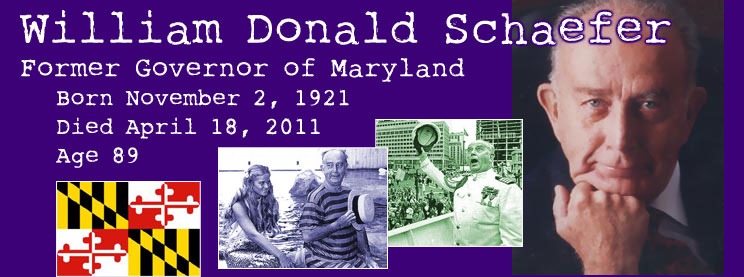 |
|
| |
|
|
| |
JD Baldwin has written a marvelous update on this duet for Gerard Tierney and Walking Dead Dude. Of note, GT has hit for the cycle (solo, duet, trio) with only 4 hits. They each get 8 points.
* * *
I got tapped to write this obit because of my personal connection with William Donald Schaefer. Here is the extent of that connection:
"Good morning, Governor."
"Hello, son, how are you?"
"Fine, sir, thanks."
Once every other week or so for a couple of years. Also, he knew I was a computer guy (because I was usually wearing a nametag that said so), and he would occasionally joke about having me fix the state's computers. I don't mean to exaggerate our acquaintance, but apparently it was enough to get me assigned the update.
With the exception of where I live now, I have spent more time living in the capital of Maryland than anywhere else in the lengthy and varied list of my residences. (I do not consider myself a Marylander.) When I first met the governor in 1989 on one of my fairly frequent visits to Chick and Ruth Levitt's deli on Main Street, I thought it was kind of a big deal just because he was, you know, the governor. (Speaking of Maryland legends, I really did kind of know Chick.)
I didn't realize I was meeting a political legend. I should have, because that's what Schaefer already was in Maryland, having been the mayor of Baltimore the first time I lived in that state, a post in which he served for far longer than any other person, ever, going back to founding mayor James Calhoun himself in the 18th century. (Calhoun served ten years, and pretty much everything in the eastern half of Maryland's mainland is named after him. Schaefer served for sixteen years.)
If you met the man with no idea who he was, you would think to yourself, "This guy belongs in politics." Most people who have met him briefly, if asked about the encounter, will remember the same thing first: He had a hell of a strong handshake. Then they'll remember how warm and personable and just plain likable the man was.
He was so likable, he could get away with murder, politically. He'd say things that would get any other politician branded racist, sexist, homophobic and just plain evil ... and his constituents would just smile and say to themselves, "That's our Governor." (They would say "Governor" mentally to themselves long after he left that office to serve as state comptroller, by the way.) I don't think he'd been governor for ten minutes when he said, within hearing of a reporter, that the Eastern Shore of Maryland was a "shithole." (It is a shithole, by the way.) Most politicians would have their staffs spinning apologies and "clarifications" for about three news cycles after a "gaffe" like that. Schaefer dealt with it by simply treating it as if it wasn't a gaffe ... because, basically, it wasn't. It was his opinion, and fuck you if you didn't like it.
Schaefer put his predecessor Marvin Mandel's portrait up in the State House. It hadn't hung there because Mandel was a corrupt political racketeer who actually went to prison for fixing legislation to favor local gambling concerns. Interestingly, Schaefer's newfound compassion for Mandel did not extend to his other predecessor, Spiro Agnew, whose official portrait was left in a storage closet as Mandel's was hung.
One of the most entertaining political dynamics ever was the relationship between Schaefer and his successor, Parris Glendening. All you really need to know about Glendening is that the man was just a dick. How he succeeded in politics to the degree he did is a total mystery to me, because he had no instinct for what people will and won't put up with. Maybe he thought that because Schaefer got away with so many outrages, he could too. (He was wrong. When Glendening restored Agnew's portrait in the State House, there was a real backlash over it. Glendening still probably doesn't understand why.)
Schaefer didn't actually call Glendening a "dick" in public, but as state comptroller during Glendening's governorship, he openly referred to him as "the Ayatollah." It was around this time that "Schaefer: He Says What You Think" bumper stickers started appearing throughout Maryland. Not on the Eastern Shore, but most other places. Robert Erlich, who took over the governorship from Glendening, never hid the fact that he found Schaefer's antics amusing, and that probably contributed to the very friendly relationship the two of them had.
Enough rambling. Here's Schaefer's real achievement: He was that rare politician whose popularity endured despite the fact that he was an honest man to the end.
—JD Baldwin
|
|
| |
|
|
| |
 |
|
| |
|
|
| |
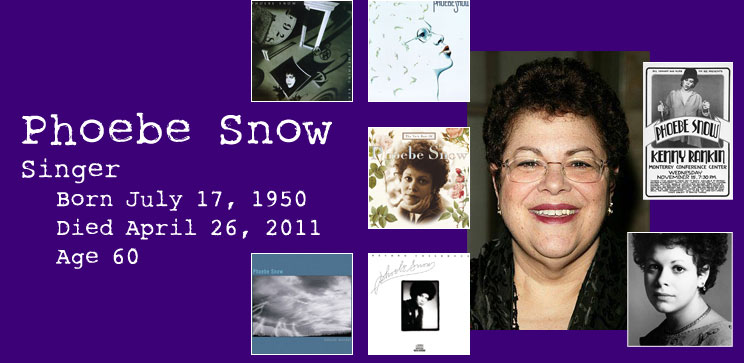 |
|
| |
|
|
| |
I discovered Phoebe Snow. No, really, I did. Much like I discovered Laura Nyro and Kenny Rankin, too. I think it may be hard for today's young people to understand the private world we had with our beloved musical heroes. They weren't all over TV, there was no internet, they weren't even playing live in a theater near us, necessarily. First you had this one-on-one connection with some guy on the radio, he played you an amazing song, you scrounged around a record store or two until you found the album, you brought it home and it was you and the artist. Just the two of you. No one else. Maybe you introduced her to your best friend, but you didn't text, facebook, tweet, send a link, download, ringtone, or anything like that. You could sing it. Or try to play it on your guitar. But that was the extent of it.
After I discovered Phoebe Snow, everyone else in my cohort discovered her and she made it to Saturday Night Live and to a second album, and eventual mega-stardom.
Only she didn't.
Her voice was enormous, but her career ended up as small as a performance here, a record there, and a General Foods International Coffees jingle everywhere. And that's because she chose to stay home with her brain-damaged child for 31 years.
Her choice. Our loss. First of the songwriter and the performer. For years and years and years. Then the woman, forever and ever.
Bill Schenley, Dead People Server, Deepstblu, Denise, Direcorbie and Monarc reluctantly put Ms. Snow on their lists. Each gets 11 points.
— Amelia
|
|
| |
|
|
| |
 |
|
| |
|
|
| |
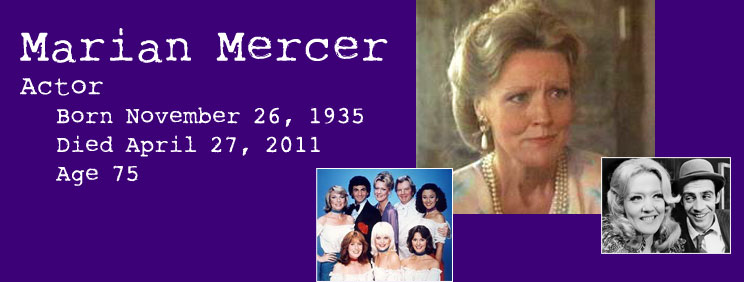 |
|
| |
|
|
| |
Marian Mercer's big break came when she was cast in a revue called New Faces of 1962, a collection of sketches, comedy bits and songs similar in form to the five New Faces revues that had come before it over the years. Unlike the others, though, the 1962 version was a flop that ran for less than a month, befitting a format that was dying thanks to changing tastes and, even more so, to television.
But that short run was enough for Marian, and hers is the only name that jumps out from the cast list. She wound up doing a lot of theater on Broadway and in Los Angeles. After her Tony win in 1969 as Marge in Promises, Promises, she was suddenly all over the television dial, doing dozens of guest spots on sitcoms and variety shows, usually as somebody's wife and, therefore, the target of a lot of dumb jokes. Marian did better when, in 1980, she landed the role of the supervisor of a crew of waitresses on a workplace sitcom called It's a Living, which ran on ABC for two years and, after a long break, for another three years in first-run syndication.
Several more series followed. Marian worked steadily on stage and in movies and TV up until 2000, when she just couldn't work anymore. She spent her final years in the grip of Alzheimer's at the Motion Picture & Television Country House and Hospital, where beloved old actors go to die. A couple of years before Marian's death, there came word that the facility's long-term care unit might be closing soon (it didn't), and the picture that accompanied the wire story about it was of Marian Mercer and her husband, Patrick Hogan, sitting quietly together. Patrick is looking at his wife with love and pain in his eyes, and his wife is looking at nothing. Nothing at all.
Born with the Defect gets 8 points for the hit and 5 more for the solo. Total: 13.
— Brad
|
|
| |
|
|
| |
 |
|
| |
|
|
| |
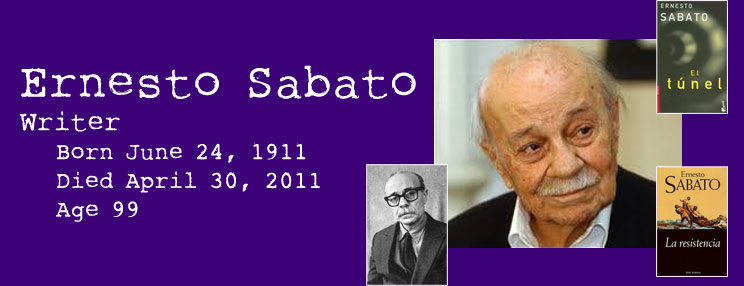 |
|
| |
|
|
| |
Ernesto Sabato was Argentina's most celebrated novelist. He was one of the greatest Spanish-language writers of the 20th century. All those guys we think influenced the world of magical realism, most notably Gabriel García Márquez, were first influenced by Sabato. Sabato's best-known novels, The Tunnel and On Heroes and Tombs, were crime stories that ranged into fantasy and the surreal while examining the depths of love, melancholy and murder. His articles and essays touched on philosophy and world literature, and his social criticism sometimes chided Borges and other fellow writers for failing to speak out on current events. (So said the Wash Post obit.) In his youth, Sabato was a physicist, assisting in breaking the uranium atom, and while he was being a physicist in Paris, he was hanging out with surrealists, so that made him an artist, I think. And then because he was a prominent intellectual, his politics were worn on his sleeve. So in 1983, Sabato took on another career. Raul Alfonsin appointed him to the National Commission on the Disappearance of Persons. It was his job to oversee the compiling of testimony from survivors and documents long hidden about those tortured, killed and just plain disappeared by the military from 1976 to 1984. Argentinians were shocked to learn of the details of the 30,000 dead. Sabato believed that only democracy could save people from this fate again, and I couldn't agree more. I shudder to think of the need for a Commission on the Disappearance of Persons. As bad as things get here, that is not in our future.
My kind of hit, wouldn't you say? I have to say I wasn't keeping track of his age, and one more year on my list would have been fatal, points-wise. So, phew, I get 2 for the hit and 5 for the solo. Total: 7.
— Amelia
|
|
| |
|
|
| |
|
|
|

